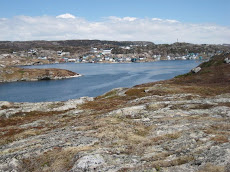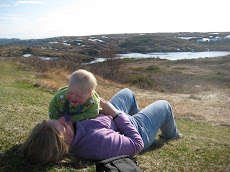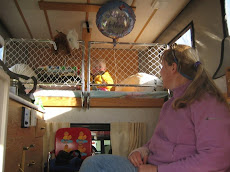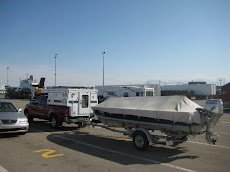As several of you fine readers and vicarious adventurers have pointed out in emails to Nat and me, it has been quite a few weeks since our last posts. Hopefully Nat’s posts of earlier today went some distance in alleviating concerns that we might have fallen of the edge of the Earth (granted, it is not far from here) or may have been abducted by aliens (although I did see some sort of unidentified flying object a few weeks back – it was flying and I did not identify it…) or that we entered the witness protection program or that we had a catastrophic failure of our Local Access Portals That Obviate Personal Struggles (LAPTOPS) or some other equally time-wasting reasons for getting on with this missive.
Since my Tilting Rare Bird report we have traveled countless kilometers (well, not entirely countless, we have the COW’s odometer’s trip meter set), visited St. John’s, Come By Chance, South Brook, Fleur-de-Lys, La Scie, Jackson’s Arm, Port au Choix, Birds Cove, Pistolet Bay, Bide Arm, Green Point, Barachois Pond, Burgeo, Francois, Red Indian Lake, Davidsville, Musgrave Harbour, and Gambo, some for the first time, some for the second time, St. John’s for the umpteenth time, to name more than a few.
The slow start I got with my bird list has been improving along with all this travel. And although I have not had much dedicated birding time, my binoculars are always strapped around my neck or within reach, so I would like to think that few birds escape my notice.
A quick sketch of the avian highlights thus far: Snow Geese flying over Rose Blanche; a Port aux Choix King Eider; hundreds of Sooty Shearwaters pushed in ahead of the oncoming fog bank at St. Vincent's, perhaps to feed on the capelin which had recently arrived; Great Blue Herons in the Codroy Valley (according to a recent newspaper article, they were actually documented as nesting, a Newfoundland first); a Cooper's Hawk in St. John's; a dark phase Gyrfalcon in Port aux Choix; hundreds – more likely thousands – of shorebirds (perhaps my favorite family of birds, especially Ruddy Turnstones) in the past few weeks; a Parasitic Jaeger off Fogo Island; Bonaparte's Gull in Port aux Basque; a Roseate Tern in Elliston; a Dovekie, that littlest of Atlantic alcids (the family that includes puffins); Red-necked Grebe and Bank Swallow in Burgeo; Common Grackle on the road between Port aux Basques and Rose Blanche; and Northern Harriers, Sharpies, and Merlins aplenty. I regularly see both crossbills, especially the White-winged, which I always enjoy. A surprise has been how long it has taken me to see Pine Grosbeak this trip; my first one was not until 19 August. This is said to be a common bird hereabouts.
In Burgeo last week we camped at a Sandbanks Provincial Park, which is nestled in "tuckamore", a scrubby natural community of nearly impenetrable Black Spruce and alder. For three days the warblers were nearly dripping off the branches: Palm Warblers were the most abundant, with hundreds visible in the span of 15 minutes. It was a good test of my fall warbler identification as there were so many warblers, eleven that I identified: Tennessee, Yellow-rumped, Palm, Bay-breasted, Blackpoll, Black-and-white, redstart, waterthrush, Mourning, yellowthroat, and Wilson's!!!
After a few fog-bound days in Francois (I am glad Nat ‘fessed up about her outbound sea-sickness), the weather finally cleared (which is a relative thing here in Newfoundland) the morning we took the coastal boat back to Burgeo. The three of us spent almost the entire ride on the exposed bow, taking in the sights that were hidden from us just a few days earlier. As the boat steamed a few kilometers from shore, we saw quite a few raptors, mostly Sharp-shinned Hawks and Merlins, but we also had a Peregrine Falcon. (These off-shore sightings just further excite me for a future project to study the role of off-shore islands in migration – Little Mount Desert Rock, 25 miles south of Bar Harbor, out toward the middle of the Gulf of Maine, complete with a lighthouse and a refurbished light-keepers house, is the perfect site.)
As I have long espoused, the trick to seeing birds is to look for them, and spending so much time in the great outdoors helps.
Total Newfoundland birds: 136
Monday, September 01, 2008
Subscribe to:
Post Comments (Atom)



































1 comment:
Migration is on here, too-shorebirds on the move and songbirds filling the night skies...summer seems to have never happened at all...leaves are taking their time changing but we had our first frost last night. Thanks for posting all the photos, I can't wait to see more...miss you guys...
Post a Comment